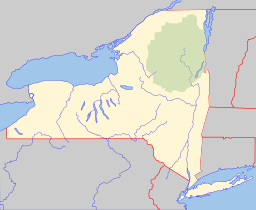
Back بحيره اوتسيجو ARZ Otsego Lake (lanaw sa Tinipong Bansa, New York) CEB Отсего (кӳлĕ) CV Otsego Lake (New York) German Otsego EO Lac Otsego French Lago Otsego Italian Otsegomeer Dutch Отсиго (озеро) Russian
| Otsego Lake | |
|---|---|
 Southwest end of Otsego Lake | |
| Location | Otsego County, New York, United States |
| Coordinates | 42°45′23″N 74°53′46″W / 42.7564°N 74.8961°W[1] |
| Type | Lake |
| Primary inflows | Hayden Creek, Shadow Brook, Trout Brook, Cripple Creek, Leatherstocking Creek, Willow Brook, Mohican Brook, Brookwood Creek, Glimmer Glen Creek |
| Primary outflows | Susquehanna River |
| Catchment area | 74 sq mi (190 km2)[2] |
| Basin countries | United States |
| Max. length | 7.8 mi (12.6 km)[3] |
| Surface area | 4,046 acres (16.37 km2)[3] |
| Average depth | 82 ft (25 m)[3] |
| Max. depth | 167 ft (51 m)[3] |
| Water volume | 117,000,000,000 US gal (440,000,000 m3)[4] |
| Residence time | 3 years[5]: 1 |
| Shore length1 | 20.3 mi (32.7 km)[3] |
| Surface elevation | 1,194 feet (364 m)[1] |
| Islands | Sunken Island (sunken), Eel Island (sunken) |
| Settlements | Cooperstown |
| 1 Shore length is not a well-defined measure. | |
Otsego Lake is a 4,046-acre (16.37 km2) lake located in Otsego County in the U.S. state of New York. It is the source of the Susquehanna River and largest lake in Otsego County.[1][2] The Village of Cooperstown is located at the lake's southern end. Glimmerglass State Park is located on the lake's northeastern shore, and includes Hyde Hall, a large mansion constructed in 1817, that overlooks the lake. The Glimmerglass Opera, opened in June 1987, is located on the western shore.[6][7][8]
Between 10,000 and 12,000 years ago, glaciers of the Wisconsin glaciation filled the valley. Otsego Lake was formed when an ice tongue from a glacier carved out the Susquehanna River Valley. As the glaciers melted slowly, they filled in the valley they carved out. The lake takes its name from the Iroquois Indians, who inhabited the area around the lake in and before the 17th century. The name Otsego is from a Mohawk or Oneida word meaning "place of the rock", referring to the large boulder near the lake's outlet, today known as Council Rock.
The lake's role in the state and local economy has led to a concentrated effort to protect and manage it. In 1935, the New York State Conservation Department performed the first biological survey of Otsego Lake. In 1968, the State University of New York at Oneonta (SUNY Oneonta) gained access to the lake, a location to build a field station and a biological research facility. Also at this time, the Otsego County Conservation Association (OCCA) was formed by a group of local landowners and sportsmen concerned about the water quality. SUNY Oneonta and OCCA collaborate on water quality improvement projects. The Otsego Lake Association, a not for profit group, makes sure that the Otsego Lake Watershed Management Plan is enforced. Today the lake is used recreationally and for sporting activities such as fishing.
- ^ a b c "Otsego Lake". Geographic Names Information System. United States Geological Survey, United States Department of the Interior. Retrieved August 11, 2015.
- ^ a b "Biological Field Station - About Otsego Lake". www.oneonta.edu. Oneonta, NY: State University of New York at Oneonta. 2015. Archived from the original on August 10, 2015. Retrieved August 11, 2015.
- ^ a b c d e New York State Department of Environmental Conservation. "Otsego Lake". www.dec.ny.gov. Archived from the original on August 13, 2020. Retrieved November 2, 2020.
- ^ "A Plan for the Management of the Otsego Lake Watershed" (PDF). www.oneonta.edu. Oneonta, NY: State University of New York at Oneonta. April 1998. Archived (PDF) from the original on August 1, 2021. Retrieved November 2, 2020.
- ^ "ALICE BUSCH OPERA THEATER". The Glimmerglass Festival. Archived from the original on July 2, 2015. Retrieved June 28, 2015.
- ^ Hardy, Hugh (2013). Theater of Architecture. New York: Princeton Architectural Press. pp. 185–189.
- ^ Anderson, Grace (1988). "Open-air opera". Architectural Record (August): 90–93.

